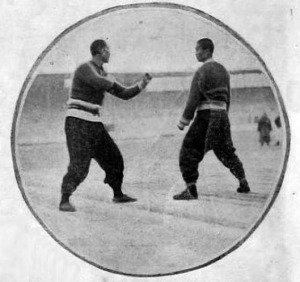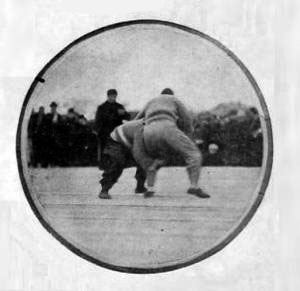Xingyi Quan - Su Dong Chen - Applications
Saturday, March 30, 2019
Thursday, March 28, 2019
Tuesday, March 26, 2019
Zǐwǔ Sword (子午劍), by Huáng Hànxūn (黃漢勛) Translation by Scott M. Rodell
最高原理則變化無窮,忽開忽合,收閉如意,瞻前顧後,左右相盼,高來低挑,低來高點,無踪可追,無跡可尋,天地國親師五行並濟,若太極之包羅,如六合之放縱,劍不過腦,自古已然,毋以劍作刀致貽方家之笑,後之學者其勉之哉。
Zuìgāo yuánlǐ zé biànhuà wúqióng, hū kāi hū hé, shōu bì rúyì, zhānqiángùhòu, zuǒyòu xiāng pàn, gāo lái dī tiāo, dī lái gāo diǎn, wú zōng kě zhuī, wú jì kě xún, tiāndì guó qīn shī wǔháng bìng jì, ruò tàijí zhī bāoluó, rú liùhé zhī fàngzòng, jiàn bùguò nǎo, zìgǔ yǐrán, wú yǐ jiàn zuò dāo zhì yí fāng jiā zhī xiào, hòu zhī xuézhě qí miǎn zhī zāi.
The highest principle is limitless variation. Suddenly opening, suddenly closing, sealing closed as one likes. Attentive forward and back, left and right. (Attacked) high, (respond with) spring cut from below. (Attacked) low, (respond with) pointing cut from above. (Leave) no track that can be chased, no trace to be sought. Heaven and earth, country, family, and teacher (representing the five elements), work together, as the taiji principle embraces everything, is as the six directions are unrestrained. The jian does not pass over the head. Since ancient times, this was already so. Using the jiàn like a saber will cause learned men to laugh, students are encouraged to study properly.
Quoted from the Zǐwǔ Sword (子午劍), by Huáng Hànxūn (黃漢勛), 1958
Trans.- Scott M. Rodell
Trans.- Scott M. Rodell
Notes and Commentary-
In the first line, biànhuà wúqióng is translated as limitless variation. A more common and literal translation might be transform or change endlessly. Given that an essential element of jiànfǎ is versatility, especially the ability to adapt effortlessly to changing conditions, applying a wide variety of techniques and strategies, limitless variation fits the context. The lines that provide responses to receiving blows from above and below, mention two basic cuts common to different systems of jiànfǎ. When receiving a high line cut, the text gives tiāo as the response, and provides diǎn as an answer to a low line attack. Given that are other possible responses to both actions from one’s duìfāng, the author likely chose these examples to stress one common strategy in jiànfǎ. That strategy is to open a door, i.e. invite an attack, then allowing the duìfāng to make his or her intention clear, intercept that action with a cut to the sword arm. Zhuāngzi describes, "The art of the jiàn is to deliberately expose a weakness, giving the enemy the impression they have the opportunity to attack. Your hand moves after the enemy, but your jiàn strikes first,” (夫為劍者,示之以虛,開之以利,後之以發,先之以至). Concerning leaving no track or trace for your duìfāng to follow, if one gives up oneself and follows others, there is no track for the duifang to find and follow.
More than one classic of jiànfǎ ends with a line mentioning that wielding the sword like a saber would cause laughter amongst the immortals or learned men. Two examples are the Tàijí Jiàn Gē (太極劍歌) and the Hòu Jiàn Jué (後劍訣). By mimicking these classics, Huáng Hànxūn, author of the Zǐwǔ Sword, is demonstrating his knowledge of these earlier works.
The name of this sword system is an interesting choice. Zǐ and wǔ refer to two of the twelve times of the day, namely midnight and noon, and imply an ebb and flow between yin and yang. This idea fits nicely with the manner in which the jiàn is wielded. Zǐwǔxiàn (子午線) also refers to the central line of the body which the swordsman looks to control with the way he or she deflects and cuts.
FOUND HERE
Sunday, March 24, 2019
Friday, March 22, 2019
The Art of the Jian - Trans. Scott M. Rodell
莊子曰:
夫為劍者,示之以虛,
開之以利,後之以發,
先之以至。
Zhuangzi Said:
"The art of the jian is to
deliberately
expose a weakness,
giving the enemy the
impression they have
the opportunity to attack.
Your hand moves after the enemy,
but your jian strikes first."
Trans. Scott M. Rodell
Found HERE
Wednesday, March 20, 2019
Lei Tai competitions – Kung Fu fighting in the good old days - NY Sanda.com
In October 1928 three Chinese generals, Zhang Zhi Jiang (张之江), Li Lie Jun (李烈鈞) and Li Jing Lin (李景林) organized the first public full contact competition in China. The purpose of the competition was to select qualified teachers for the newly founded Central Kuoshu Institute (中南國術館),
Of course, many traditional masters did not compete because they believed their skills could only be proven in serious duels and not “sporting” contests. However, the event attracted hundreds of the best Chinese martial artists who participated in three separate divisions; (1) “boxing”, (2) weapons sparring ad (3) wrestling (aka Shuai Jiao).
In the “boxing” division, competition was suspended after a few days due to the injuries. The event was held with very few rules, but more importantly without any gloves or protective gear. Like the early UFC’s many fighters injured their hands and legs, unaccustomed to actually striking the elbows and knees used to block. The last 12 contestants were not permitted to continue, the public excuse being the “fear of killing off some of the greatest masters of the time”. The overall winner was voted on by a jury of his peers!
The next year a similar event was held in Hangzhou, China. This event was also organized by Li Jinglin, then acting as vice-dean of the Central Martial Arts Academy. This time there were 125 entrants for the “boxing” or “free fighting” (San Shou) competition which was held November 21-27. The event was very popular, the audiences every day numbered in the tens of thousands.
The tournament had few rules, they were not allowed to attack the eyes, throat or groin – anyone breaching these rules was disqualified. However, the event also had a flaw in the rules, in the event of a draw BOTH contestants advanced to the next round. By the end of the first day, more than half the contests had ended in draws! The rules were quickly changed so that in the event of a draw both contestants were eliminated.
With this, the competitors didn’t hold back and many people were hurt, mostly with head injuries. The judges’ committee instituted a new rule in response, stating that contestants were not allowed to continually attack the head! The history of Chinese martial arts fighting competitions is full of instances of poor organization, irrational rules, random rule changes and rules which defy logic and reality of combat.
Zhao Daoxin was a disciple of Zhang Zhaodong and was famous in Tianjin’s martial arts community. Zhao was only 20 at the time and at the beginning of his martial arts career, yet managed to achieve 13th place. His notes on the competition included these observations;
“Those ‘orthodox inheritors’ of traditional martial arts, regardless of whether they were lofty monks or local grandmasters, were either knocked out or scared out of the competition”
Zhao also noted;
“Even though, at registration, every competitor identified themselves as belonging to a traditional style, every one of them engaged in secret auxiliary combat training”
By the 1920’s both Western boxing and Japanese Judo had found there way to China and had made a huge impact on many martial artists. However, due to nationalistic and style pride, many did not openly admit to it!
Other examples of denial of reality manifested themselves at the event. The 2nd place winner, Chu Kao-Lou, openly admitted he also trained in Western boxing. One Taiji master complained that Chu’s fighting style was not using Chinese Martial Arts, to which Chu’s brother, Chu Kao-Chen, challenged the Taiji master. In respond, the Taiji master didn’t dare to accept that challenge.
Other quotes regarding the event
– 这次比赛没有看到高深的内功,没有发人于丈外的场面
You don’t see high level internal power, and Faijin that send people flying 10 feet away in this tournament.
You don’t see high level internal power, and Faijin that send people flying 10 feet away in this tournament.
– 太极打法毫无建树,四量难拨千斤
The Taiji principle didn’t work well. 4 oz could not defeat 1000 lb.
The Taiji principle didn’t work well. 4 oz could not defeat 1000 lb.
– 也就是说号称以巧取胜的中国功夫 实际上也是在跟人拚勇力比高大
The taller, heavier, stronger guys won in that tournament.
The taller, heavier, stronger guys won in that tournament.
– 要学打擂台的拳术
After this tournament, people wanted to learn the style that can be used on the Leitai.
After this tournament, people wanted to learn the style that can be used on the Leitai.
http://www.nybestkickboxing.com
http://www.nysanda.com
Lei Tai competitions – Kung Fu fighting in the good old days
http://www.nysanda.com
Lei Tai competitions – Kung Fu fighting in the good old days
Sunday, March 17, 2019
Bagua Zhang - Push Hands - Marcus Brinkman
Bagua Zhang - Push Hands
My teacher Marcus Brinkman - Learn Internal Kung Fu at Boulder Internal Martial Arts
Friday, March 15, 2019
Rare Chinese martial arts demo
Wednesday, March 13, 2019
Monday, March 11, 2019
Saturday, March 9, 2019
Thursday, March 7, 2019
"The sword’s qì is as a rainbow" - trans by Scott Rodell
劒氣如虹劍行似龍
劍神合一玄妙無窮
廣平楊澄甫題
Jiàn qì rú hóng jiàn xíng shì lóng
jiàn shén hé yī xuánmiào wúqióng
Guǎng Píng Yáng Chéngfǔ tí
The sword’s qì is as a rainbow, the sword moves like a dragon.
Sword and spirit meet as one, its profundity is boundless.
Yang Chengfu of Guangping
translation by Scott Rodell
Tuesday, March 5, 2019
Saturday, March 2, 2019
Bagua Zhang - Snake Palm Training - Carsten Stausberg
Bagua Zhang - Snake Palm Training - Carsten Stausberg
Subscribe to:
Posts (Atom)






